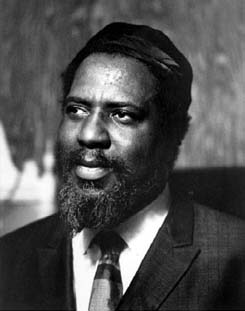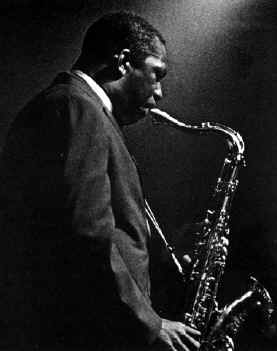THELONIOUS MONK & JOHN COLTRANE / “Monk’s Mood”
Monk and Trane, what a combination. Here is previously unknown (not just unreleased) music—few people even knew this concert was recorded. The Carnegie Hall concert was recorded by the Voice of America for possible radio broadcast abroad, put in a non-descript box, and promptly forgotten about. Unlike a previous live recording, this one had excellent audio fidelity and was an actual Monk & Trane concert rather than Trane just sitting in some numbers.

The music was at a high point in Monk’s career and marks the beginning of Trane’s ascendancy into the stratosphere of jazz luminaries. But don’t listen to it as a historical document. Listen to it as contemporary jazz. Listen to it and see if any recent quartet has put out music anywhere near as fresh, as audacious and as swinging as this. This shit is astounding.
Of course, I am biased. I’m a Trane freak and Monk was the first of the beboppers to grab my ears. The legendary pairing of Monk and Trane was always, always high on my list of historic occasions. But in '57, I was only ten years old. Not then yet aware of this music. Oblivious to the flame that was to consume me for the rest of my life.
I didn’t know (and it would take me another six or seven years to fully catch up to) this incandescent duo. All of which is to say, don’t feel no ways shamed if you’ve never heard Monk and Trane (although you should be shamed if you claim to love black music and you’ve never heard Trane). Their pairing was but for a short time during the summer of 1957. Still, all credible jazz historians point to this crucial juncture as the turning point in Coltrane’s career. This is where history started. This was the breakthrough. On this magnificent recording you can hear the new bird break out his shell.
Yet, I’ve got to admit, as much as I dig Trane, Monk was the man on this night. I have recordings of Trane playing with Miles in Europe (after Trane left Monk) and Trane is absolutely killing with staggering intensity, just crushing everything he touches, everybody else in the band just along for the ride. On that last tour with Miles, everything is diminished after Trane roars, and before he enters, all is just a prelude. I do not exaggerate. Trane was just that mighty. But, nonetheless, Trane clearly had to take a backseat to Monk.
For me, the value of this recording is that you fully feel Monk’s power as a pianist. This is a preview. This leads you to understand why Trane sought out someone with the power and stamina of McCoy Tyner. Once you hear the massive movement of Monk’s chords, the unerring daring of his timing as he hesitates, syncopates, anticipates by adjusting where, when and how he plays his amazing arpeggios, his mesmerizing progressions. Damn, it’s breathtaking.
I know, I know. I’m gushing.
And I know, for most folk who first hear this, it seems like just good, swinging jazz. But I challenge you. Go back and find other music recorded in 1957. Go back and play some of those records and then play this one and you will see, you will hear just the musical earth move, you will understand that this was a complete refashioning of the aural landscape.
Everything is here to hear. The essence of bebop stripped down to the skeleton framework. Monk understood the music so well, that he took a form, bebop, noted for its profuse outpouring of notes and was able to condense it down to one or two notes per measure. Listen to “Evidence” for evidence that Monk was the architect who understood the underpinnings of bebop better than anyone.

And then there is the blues of “Blue Monk.” You know the blues was the hand that Trane fanned with, but again, no matter how fast Trane was fanning, he can’t match the cyclonic power of Monk at the piano dropping bombs. Trane be preaching hard but what you really hear are Monk’s amen-chords sounding like a sacred chorus of revelers urging on the young horn master-becoming/coming into his own. And after Trane’s torrent of notes, Monk moves into outer space with a solo that employs space the way Trane did notes. Whereas Trane played fast and furious, Monk darts and dodges. Trane was a full back, full speed ahead. Monk a crafty halfback weaving through the line with nary a tackler touching him as he shifts from sound to sound—where did he go, how did he do that?
But the piece-de-resistance here is the opening “Monk’s Mood” during which Coltrane moans the melody like it was a prayer and Monk embellishes with all the brilliance of a Baptist pianist counterpointing the preacher. First Monk gives us a map of the terrain with a solo chorus and then Trane eases in, and from then on, Monk gives a textbook definition of what it means to “comp” (accompany). This one selection should be required study for all pianists.
There are more gems in these two 25-minute sets, recorded in their entirety except for the closing theme, “Epistrophy,” ending in mid-flight. Buy the record, you will not be disappointed.
If you love jazz, you got to get to this. Monk and Trane: sublime.
—Kalamu ya Salaam
This entry was posted on Sunday, October 16th, 2005 at 2:10 am and is filed under Classic. You can follow any responses to this entry through the RSS 2.0 feed. You can leave a response, or trackback from your own site.
One Response to “THELONIOUS MONK & JOHN COLTRANE / “Monk’s Mood””
October 22nd, 2005 at 4:24 am
Everytime I read a Breath Of Life post it’s like a lesson, a masterclass of the music that I love so much, the right words to make sounds understood in some other dimensions. Monk and the Man Supreme… as you said, sublime!
Leave a Reply
| top |